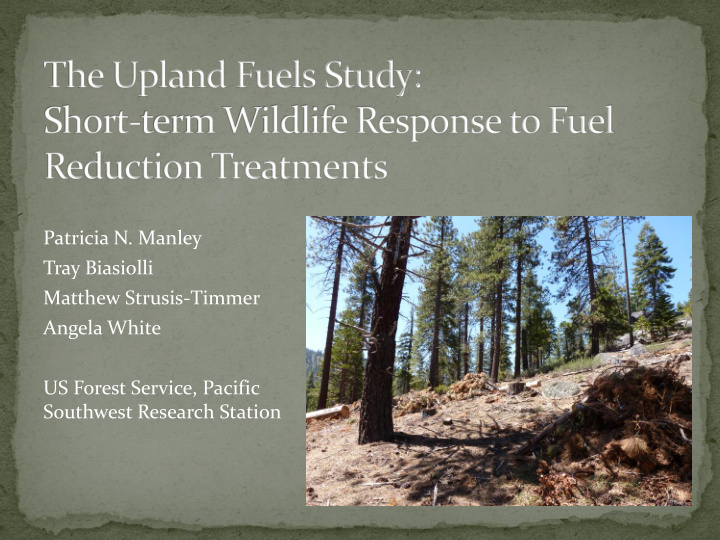



Patricia N. Manley Tray Biasiolli Matthew Strusis-Timmer Angela White US Forest Service, Pacific Southwest Research Station
Several tools available to predict fire behavior Can we meet multiple objectives?
Investigate how fuel reduction treatments impact fuel loads, forest structure and wildlife Little data on relative impacts of different prescriptions
Small mammal and avian focus Important component of Tahoe biodiversity Readily detected Treatments at the stand- scale Prey base for several sensitive species
Eight paired treatment sites Before-After Control- Impact Design Overstory Residual Fuel Unit Ownership Treatment Treatment Mechanical thin to Masticate and surface Treatment MCK 13-3 USFS Unit Pre 1 Pre 2 Post 1 Post 2 30 ” spread slash year Mechanical thin to Masticate and surface MCK 13-3 2006 2008 2009 2010 2011 WRD 20-9 USFS 24" spread slash WRD 20-9 2006 2007 2008 2009 2010 Mechanical thin to Masticate and surface BLK 1-4 2006 2006 2007 2008 BLK 1-4 USFS 24“ spread slash TWC 3 2006 2008 2008 2009 2010 Mechanical thin to Masticate and surface WRD 20-16 2006 2007 2007 2008 2009 TWC 3 USFS 24“ spread slash MCK 13-1 2006 2006 2007 2008 WRD 20-16 USFS Hand thin to 10" Pile/burn RED 2007 2007 2008 2009 MCK 13-1 USFS Hand thin to 14" Pile/burn WLD 2007 2008 2009 2010 RED NDSLV Hand thin to 24” Pile/burn WLD NDSLV Hand thin to 24 ” Pile/burn
70 60 Mechanical treatments 50 % Canopy Cover removed greater 40 Pre-treatment proportion of tree cover 30 Post-treatment 20 10 0 Hand Mechanical 350 120 300 Live Tree Basal Area (ft3/ac) 100 Snag Basal Area (ft3/ac) 250 80 200 60 150 40 100 20 50 0 0 Hand Mechanical Hand Mechanical
700 Important habitat Coarse Woody Debris (m3/ha) 600 components for small 500 400 mammals and birds Pre-treatment 300 Post-treatment 200 100 0 Hand Mechanical 20 5 18 4.5 16 4 % Herbaceous Cover 14 3.5 % Shrub Cover 12 3 10 2.5 8 2 6 1.5 4 1 2 0.5 0 0 Hand Mechanical Hand Mechanical
Detected 63 total species Pre-treatment Post-treatment Species Richness 53 57 Shannon Diversity 3.27 3.28 Shannon Evenness 0.82 0.81
Detected 16 total species Pre-treatment Post-treatment Species Richness 14 14 Shannon Diversity 1.87 1.93 Shannon Evenness 0.71 0.73
150 Analyzed response of 9 100 % Change relative to Control 50 species 0 -50 Mechanical Year 1 * -100 Mechanical Year 2 -150 2 species showed Hand Year 1 -200 significant decline in Hand Year 2 -250 * first year following -300 TAAM TAQU TASE TASP GLSA TADO SPBE SPLA PEMA treatment Chipmunks Tree Squirrels Ground Squirrels Mice
Mechanical Hand 10 Abundance of birds 5 % Change in Overall Bird 0 decreased following Abundance -5 treatment -10 -15 Year 1 -20 Year 2 Abundance of small -25 mammals increased 60 % Change in Total Small Mammal following treatment 50 40 Abundance 30 Neither pattern statistically 20 10 significant 0 -10 -20 Mechanical Hand
Hand and mechanical treatments consistent with maintenance of community evenness & richness Bird abundance may decline slightly after treatment Treatments may increase small mammal abundance – mechanism unclear Mixed response for carnivore prey base – species-dependent
Limited by treatment variation, large population fluctuations, short-term response Expand sample size Examine longer-term response Research response to wider range of treatment prescriptions Use of complementary, non-experimental approaches
Bruce Pavlik Alison Stanton Dennis Murphy Brandon Collins Gary Roller USFS Lake Tahoe Basin Management Unit Nevada Division of State Lands Homewood Mountain Resort Southern Nevada Public Lands Management Act
Recommend
More recommend